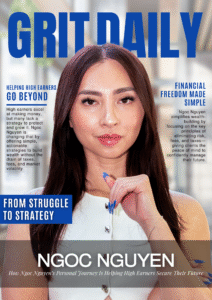In a world of constant change, leaders face unique challenges that demand practical solutions. This article provides valuable perspectives from established experts on overcoming obstacles and achieving success in various aspects of organizational evolution. It offers actionable advice for decision-makers looking to guide their teams through transitions without compromising their core values.
- Manage Team Morale During Leadership Transition
- Guide Nonprofit Through Digital Overhaul
- Rebuild Core Infrastructure Amid Rapid Growth
- Pivot Product Focus to Academic Content
- Restore Team Confidence After Leadership Change
- Maintain Trust During Supply Chain Breakdown
- Expand Services Beyond Content Marketing
- Overhaul HR Function to Build Trust
- Transition POSH Training to Virtual Format
- Shift Business Model to Commission-Based Setup
- Ensure Continuity During Full-Scale War
- Shift Client Acquisition to Inbound Strategy
- Restructure Service Model for Sustainable Growth
- Maintain Core Values During Franchise Expansion
- Transition to Fully Remote Operation
- Set Clear Goals During Organizational Change
- Shift to AI-Driven Marketing Automation
Manage Team Morale During Leadership Transition
One significant period of change in our organization occurred when we experienced a sudden shift in personnel at the director level. A key director unexpectedly decided to leave the company, which left a substantial gap in our leadership team and threatened to disrupt ongoing projects and strategic initiatives.
The biggest challenge was maintaining team morale and continuity in operations while quickly finding a suitable replacement. To manage this transition effectively, I took several steps. First, I temporarily redistributed the departing director’s responsibilities among existing team members who were familiar with various aspects of their role. This helped ensure that all critical functions remained operational and deadlines were met.
Simultaneously, I increased my presence in daily operations to provide support and guidance, holding regular meetings to keep the lines of communication open and to address any concerns from the team. We also accelerated our recruitment process to find a qualified replacement, emphasizing the need for a smooth and swift transition to maintain momentum in our projects.
To overcome this challenge, I focused on transparent communication, expressing the strategic vision and reinforcing each team member’s role in achieving it. By showing confidence and providing support, I was able to keep the team motivated and focused during this uncertain period.
This experience underscored the importance of having a strong succession plan and the ability to adapt quickly. My advice to others facing similar situations is to prepare contingency plans for key roles and to foster a resilient organizational culture that can withstand unexpected changes.
 Ari Lew
Ari Lew
CEO, Asymm
Guide Nonprofit Through Digital Overhaul
Navigating significant change is practically the definition of working in technology, but one instance that sticks with me involved guiding a vital community nonprofit through a complete digital overhaul. They were incredibly passionate about their mission but hobbled by a tangle of outdated, disconnected systems—think donor databases that didn’t talk to fundraising platforms, volunteer schedules managed on spreadsheets, and impact reporting pulled together manually. The potential for improvement was huge, but so was the inertia. The biggest challenge wasn’t technical; it was deeply human. Their already stretched-thin staff viewed this massive technology shift with hope and trepidation. They feared disruption to their critical work, the steep learning curve, and whether the promised benefits would materialize for the people they served.
Overcoming this required moving beyond a typical vendor relationship. We had to become genuine partners, embedding ourselves to understand their workflows, anxieties, and aspirations firsthand. My approach centered on relentless communication and translation. We didn’t just talk about APIs or cloud infrastructure; we constantly connected every technical decision back to their core goals: reaching more people, simplifying donations, and freeing up staff time for direct community engagement. We broke the project down into manageable phases, ensuring quick wins to build confidence. The intensive, hands-on training wasn’t an afterthought; it was central to the process, empowering their team to own the new tools. We celebrated milestones together, acknowledging the effort involved. It was about demystifying the technology, demonstrating tangible value early and often, and building trust by showing we were invested in their mission’s success, not just the project’s completion. Seeing them finally operate seamlessly, with data flowing easily and staff feeling empowered rather than frustrated by their tools, was the ultimate reward. It reinforced that leading change is less about imposing solutions and more about collaboratively building a bridge to a better future.
 Steve Fleurant
Steve Fleurant
CEO, Clair Services
Rebuild Core Infrastructure Amid Rapid Growth
One of the most defining moments I’ve had leading through change came during a major rebuild of our core infrastructure. We were growing quickly, and the systems that supported our early product just couldn’t keep up. Performance was slipping, technical debt was building fast, and customers were feeling it. We knew we had to re-architect parts of the platform while still supporting our users and delivering new features.
The biggest challenge wasn’t the technical complexity. It was keeping the team focused, motivated, and aligned during a high-pressure stretch. Engineers were juggling system overhauls, support tickets, and ongoing feature work all at once. That kind of context-switching drains energy and clarity. Without trust and direction, momentum can easily fall apart.
To move through it, I leaned into transparency, trust, and delegation. I made sure everyone understood exactly why we were making the changes, what the broader vision was, and what success looked like. From there, I got out of the way. We gave the team full ownership to define priorities, raise risks early, and make the calls they were closest to. No micromanaging, no second-guessing. Just clear expectations and the space to deliver.
We backed this up with consistent communication and regular recognition. Every time a piece of infrastructure improved, or a customer noticed faster performance, we shared it. That helped keep morale up and reinforced the impact of the work.
What got us through wasn’t pushing harder. It was creating clarity, trusting the team to lead, and delegating with confidence. That experience cemented something I come back to often.
 Jamie Frew
Jamie Frew
CEO, Carepatron
Pivot Product Focus to Academic Content
One of the biggest periods of change I had to lead through came during a major product pivot. Originally, we were building a tool for general web-to-audio conversion. It was working, but the user engagement just wasn’t where we wanted it to be. After months of agonizing over retention metrics, we realized we needed to focus narrowly on academic content—something our users kept hacking the platform to do anyway.
Here’s the thing: the pivot wasn’t the hard part. The team actually got behind it pretty quickly. The hard part was how uncertain everything became after that. Suddenly, all of our roadmaps, partnerships, and even our language in marketing materials were irrelevant. The biggest challenge was keeping the team calm, confident, and moving, even when no one (myself included) could see more than two steps ahead.
So I did something I hadn’t done before: I stopped talking about vision, and started talking about tempo. I told the team: “Let’s focus on rhythm, not results. If we can move fast, check in daily, and ship something every week, we’ll figure this out by sheer momentum.”
It worked. The shift from outcome-based leadership to cadence-based leadership gave everyone something to hold onto. It gave us structure during the chaos, and more importantly, it lowered the emotional stakes. We didn’t have to “solve everything.” We just had to keep the beat.
Looking back, I still believe in vision—but during a crisis or pivot, the real leadership challenge is managing morale through ambiguity. And the best way to do that might just be to give people a drum to march to.
 Derek Pankaew
Derek Pankaew
CEO & Founder, Listening(dot)com
Restore Team Confidence After Leadership Change
A couple of years ago, I had a junior manager who was not ready to lead his team. He struggled with basic delegation, causing project delays—about 80% of his deadlines were missed—and his team of eight was visibly frustrated, with two even threatening to quit. Releasing him was difficult but necessary; restoring the team’s confidence afterward was an even bigger challenge. I acted quickly, sat them down the next day, and explained the decision in a way that kept it professional—no blame, just facts about needing stronger leadership. I then outlined a clear plan: redistribute work, bring in a seasoned interim lead, and check in weekly until we hired a replacement. A month or so later, output was 20% higher, and the team was stable.
My advice in these situations is to spot the signs early and don’t hesitate to take action. When you do, be honest with the team, spare them the drama, and demonstrate that you’ve got their back with clear guidance for the next steps. It’s about trust; they’ll rally if they see you’re decisive and focused on their success.
 Marc Hardgrove
Marc Hardgrove
CEO, The Hoth
Maintain Trust During Supply Chain Breakdown
In 2021, I had to lead through one of the most unpredictable challenges I’ve ever faced: a global supply chain breakdown that affected every part of our fulfillment pipeline. Shipping costs skyrocketed, parts were delayed for months, and we had thousands of customers waiting on backordered products—with no clear delivery dates.
The toughest part wasn’t the logistical chaos. It was maintaining trust. Every delay risked customer confidence, and the team was stretched thin trying to manage expectations while staying motivated themselves.
What made the biggest difference was shifting from a reactive mindset to one built around transparency and modular problem-solving. We created a public ETA dashboard so customers could track their region-specific timelines in real time. Internally, we restructured our fulfillment model into smaller, decentralized hubs to reduce risk from single-region disruptions. And for every delayed order, we replaced generic updates with personalized messages and bonus content to turn frustration into engagement.
The surprising part? People appreciated the honesty. Even when the news wasn’t great, clear communication built more goodwill than silence ever could. Refund requests dropped, customer satisfaction improved, and the team rallied around the visible progress.
That experience cemented a lesson I’ll carry forward: during periods of change, leadership isn’t about having perfect answers—it’s about building clarity, showing momentum, and keeping trust alive when everything else feels uncertain.
 Murray Seaton
Murray Seaton
Founder and CEO of Hypervibe / Health & Fitness Entrepreneur, Hypervibe (Vibration Plates)
Expand Services Beyond Content Marketing
When we expanded from content marketing into full-scale marketing and staffing, it was a seismic shift—not just in services, but in mindset. The biggest challenge? Getting the team (and clients) to see us not as a writing shop, but as a strategic powerhouse. Internally, that meant redefining roles, upskilling, and reworking how we pitched. Externally, it meant reframing our story and proving we could deliver across channels. I overcame it by being ridiculously transparent—sharing the vision, the why, and involving the team in building the new Prose. Change gets a lot less scary when people feel like they’re part of creating it.
 Justin Belmont
Justin Belmont
Founder & CEO, Prose
Overhaul HR Function to Build Trust
Engage your stakeholders early and often. That’s the approach I used in my last corporate role as SVP HR Director for a small public company. I was hired with the remit to overhaul the HR function. My CEO wanted me to create the feel and engagement of an HR division in a large company, without additional overhead and headcount.
My biggest challenge was building trust. I was joining the company three months after the last Head of HR had left. I knew before accepting the role that my staff had no prior HR experience outside of the company. There was also a sense that I would find process and systems challenges that had never been addressed.
One key to my success was to launch an HR Advisory Council. This group included a representative from each vertical discipline and line of business. The group met quarterly, or more often if necessary, to review upcoming changes in employee benefits, systems, and HR processes aligned with the HR change strategy. My team and I would answer member questions, address their concerns, and mobilize them as our early adopter culture carriers.
The group was so engaged that they voted to change the one-year term limit to stick with the three-year strategy from end to end.
 Cheryl Haynes
Cheryl Haynes
Founder, AchieveMentor Consulting LLC
Transition POSH Training to Virtual Format
To be completely honest, one of the most defining moments where I had to lead through significant change was when we transitioned from in-person to fully remote POSH (Prevention of Sexual Harassment) training during the early days of the pandemic. This wasn’t just a logistical shift—it challenged our core belief that sensitive subjects like workplace safety and harassment prevention could only be effectively addressed face-to-face.
The biggest challenge was rebuilding trust and emotional engagement in a virtual format. These topics require vulnerability, open discussion, and safe spaces—which felt harder to achieve through a screen.
To overcome this, we redesigned our sessions to be interactive, anonymous where needed, and paced differently, using breakout rooms, real-time Q&A tools, and pre-training assessments to personalize the experience. We also trained our facilitators to pick up on tone, hesitation, and body language even in digital settings.
The outcome? Not only did the sessions remain effective, but participation and feedback actually improved. This experience taught me that adapting with empathy, rather than just technology, is what truly makes leadership impactful during times of change.
 Pallavi Pareek
Pallavi Pareek
Founder & CEO, Ungender
Shift Business Model to Commission-Based Setup
One significant change I led was shifting our model from flat-rate listings to a commission-based setup. Previously, retreat owners paid a fixed fee to list; now, we send high-value leads. It was a gamble—requiring us to rethink pricing, technology, and how I pitched it.
The biggest challenge was pushback from existing clients. I had 20 retreat owners locked in at the old rate—half loved the predictability, and some threatened to leave when I proposed the switch. One confused client emailed, “This feels like a cash grab; I’m out.” Losing even 10% of them could have tanked revenue, and I was already stretched thin keeping the site afloat.
How did I overcome it? I got ahead of the noise—called every contact personally, not just sending emails. I laid out the why: we both win. I offered a six-month grace period at the old rate to ease them in, and I showed early data—beta testers saw a booking uptick. It wasn’t smooth; plenty still left. But by month three, 80% stayed, and overall bookings rose 25%. Those calls—hours of listening and tweaking—kept trust intact. Leading through that meant owning the mess, proving the upside, and not wavering. It has paid off.
 Chris Brewer
Chris Brewer
Managing Director, Best Retreats
Ensure Continuity During Full-Scale War
One of the most challenging moments was leading our company through the early days of the full-scale war in Ukraine. Even though we were already remote-first, we had to activate and expand contingency plans practically overnight. Our top priority was ensuring the safety of our team in Ukraine while keeping client projects moving without interruption. That meant securing backup power through generators, using Starlink and mobile internet to maintain connectivity, and setting up role shadowing to ensure project continuity in case someone became unavailable. The experience underscored the value of not just remote work readiness, but deep operational resilience and strong internal communication.
 Sergiy Fitsak
Sergiy Fitsak
Managing Director, Fintech Expert, Softjourn
Shift Client Acquisition to Inbound Strategy
Leading through a period of significant change required strategic decision-making, resilience, and strong leadership. One of the biggest challenges I faced was during a major shift in our client acquisition strategy, where we moved from traditional outreach to a more inbound, content-driven approach. Initially, there was uncertainty and hesitation within the team, as it required a complete shift in mindset and processes. The biggest hurdle was ensuring seamless execution while keeping the team motivated and aligned with the new direction.
To overcome this, I implemented weekly strategy meetings to provide clarity, track progress, and address concerns. We also invested in training to ensure the team felt confident in the new approach. By refining our LinkedIn thought leadership strategy, optimizing SEO-driven content, and leveraging strategic PR placements, we successfully doubled our inbound leads within six months. This transition taught me that navigating change requires clear communication, empowering your team, and staying committed to a long-term vision—even when results aren’t immediate.
 Sahil Sachdeva
Sahil Sachdeva
CEO & Founder, Level Up PR
Restructure Service Model for Sustainable Growth
One of the pivotal times I had to lead through significant change was when I restructured our entire service model. We moved away from traditional PR retainers and shifted toward framework-based, high-impact branding and media strategy programs. It was a bold move, especially after years of success with our legacy model, but I knew change was necessary if I wanted to scale sustainably and stay ahead of industry shifts.
The biggest challenge was getting internal buy-in while managing client expectations. Some team members hesitated to break away from what was familiar, and long-term clients were used to our old structure. Despite being the founder, I overcame this challenge by leading with transparency, data, and a clear vision. I walked the team through our future positioning, built new systems around our proprietary frameworks, and rolled out the change in phases to avoid disruption.
It worked—our brand authority grew, revenue became more predictable, and we attracted higher-quality clients aligned with our evolution. Leading through that shift taught me that clarity, conviction, and communication are everything when guiding a business through transformation.
 Kristin Marquet
Kristin Marquet
Founder & Creative Director, Marquet Media
Maintain Core Values During Franchise Expansion
The most challenging moment was when I had to steer the company through rapid franchise expansion while maintaining our core values.
Growth is exciting, but it can also be chaotic if you’re not careful. We were bringing on new franchise partners at a fast pace, and I quickly realized that if we didn’t have a rock-solid support system in place, we’d risk losing the very things that made us successful in the first place.
It’s easy to talk about “customer-first values” and “doing things the right way,” but how do you make sure those ideals translate into every new franchise location?
I spent countless hours personally connecting with our new franchise owners, not just on strategy, but on mindset. We doubled down on mentorship, peer-to-peer learning, and real-world training, so no one ever felt like they were building the business alone.
It was a valuable lesson in change. It’s not about controlling every piece of the puzzle but rather empowering the right people to carry the mission forward.
 Todd Bingham
Todd Bingham
Brand President, Top Rail Fence
Transition to Fully Remote Operation
Our most significant organizational change came when we transitioned from a traditional office-based agency to a fully remote operation.
The catalyst wasn’t the pandemic many companies faced, but rather a strategic decision to expand our talent pool beyond our geographic location. This shift challenged nearly every aspect of our established operations, from project management to team culture.
My biggest challenge wasn’t the logistical aspects of remote work, but rather maintaining our collaborative creative culture that had previously thrived on spontaneous in-person interactions. Several key team members expressed serious concerns about how brainstorming sessions and creative development would work in a distributed environment.
To address this, I first acknowledged the legitimate concerns rather than dismissing them with remote work platitudes. We then established a three-month transition plan with clear milestones and feedback mechanisms. Instead of forcing one approach, we experimented with different collaboration tools and methodologies, treating the transition itself as a creative project.
The breakthrough came when we reimagined our creative process entirely rather than trying to replicate our in-office approach. We developed asynchronous brainstorming methods that actually improved idea diversity and gave team members time for deeper thinking. This approach ended up generating more innovative concepts than our previous in-person sessions, which often favored the loudest voices.
What surprised me most was how this challenge forced us to articulate and codify our creative processes that had previously existed as informal knowledge. This documentation not only supported our remote transition but also improved our onboarding for new team members and ultimately strengthened our agency’s intellectual property.
The lesson I learned about leading through change was that resistance often contains valuable insights about what people truly value. By addressing the underlying concerns rather than just the surface complaints, we were able to preserve and even enhance the collaborative culture that makes our agency special.
 Matt Bowman
Matt Bowman
Founder, Thrive Local
Set Clear Goals During Organizational Change
I’ve recently been part of a team in charge of ensuring a smooth transition during a significant organizational change. I was a sort of middleman, if that makes sense. What I learned is that it’s crucial to set clear goals and expectations. The entire process begins with defining the overall vision and objectives of the change initiative.
If you’re not part of the top leadership, as I wasn’t, it’s important to ask your top managers to clearly articulate the purpose and expected benefits, ensuring that all stakeholders understand the “why” behind the change. This clarity helps you understand what’s going on, so you can pass the knowledge down, to ensure everyone’s alignment with the efforts towards those common goals.
Finally, encourage feedback and open communication. Doing so allows employees to voice concerns, suggest improvements, and discuss challenges they face in achieving the transition goals. This collaborative approach not only enhances buy-in but also ensures that the goals remain realistic and attainable throughout the change process.
The path is not always easy, but if it’s clear, then there’s a chance the team will support the company’s efforts if they feel they’re not just pawns, but part of the transition.
 Ionut-Alexandru Popa
Ionut-Alexandru Popa
Editor in Chief and CEO, BinaryFork
Shift to AI-Driven Marketing Automation
Leading through significant change requires adaptability, clear communication, and strategic thinking. One of the most challenging transitions I led was when our marketing team shifted from traditional campaign strategies to AI-driven automation. The biggest challenge was ensuring a smooth transition while keeping the team engaged and confident in the new approach.
Many team members were initially resistant, fearing AI would replace creativity. To address this, I focused on education—hosting training sessions, demonstrating AI’s ability to enhance rather than replace human input, and providing hands-on experience. I also maintained transparent communication, addressing concerns and highlighting small wins to build confidence.
Another hurdle was aligning AI-driven insights with our brand voice and customer expectations. By continuously testing, analyzing data, and refining our strategy, we ensured AI tools worked as an asset rather than a disruption. As a result, our team successfully integrated AI into our marketing workflows, increasing efficiency while maintaining authenticity.
This experience reinforced the importance of embracing change with a proactive mindset, fostering collaboration, and balancing innovation with human expertise. Leading through change isn’t just about adapting—it’s about inspiring others to see possibilities in transformation.
 Divya Ghughatyal
Divya Ghughatyal
Digital Marketing Consultant, Gleantap








